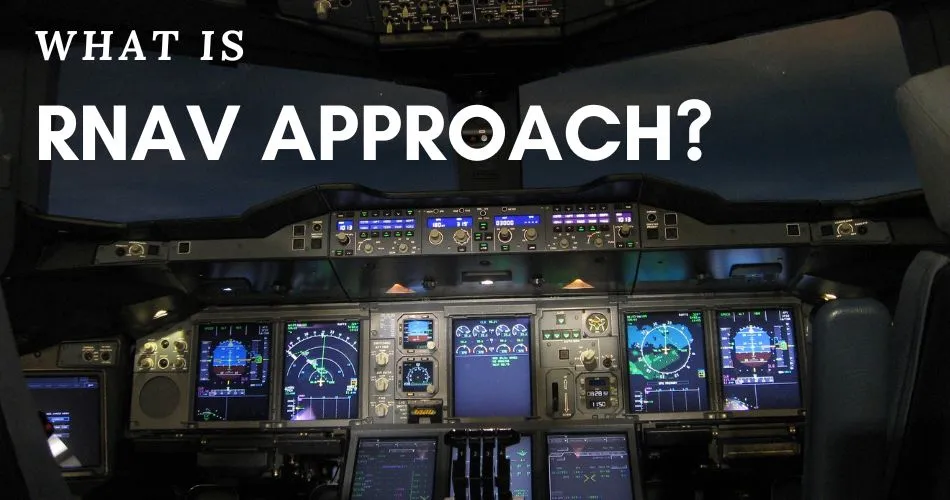As a non-aviation person, you must always be wondering how aircraft navigate safely and land accurately. Well, there are various technologies that are used by flight crews to aviate and navigate for safe flight operation.
Particularly talking about approaches and landings, there are intelligent technologies like RNAV, RNP, ILS, GNSS, VOR, NDB, and more. With these systems, today’s aircraft are capable of landing accurately, and in a safe manner.
In this technical blog, we are going to find out ‘What is RNAV Approach?’. Plus, we will also discuss how RNAV works, the types of RNAV approaches, their limitations, the process to fly the RNAV approach, and more.
There is also an RNP approach that sounds similar to the RNAV approach. We have already posted a detailed blog on RNP Approach covering the differences between RNAV and RNP. After reading this blog, you can visit it.
Table of Contents
What is RNAV Approach? How does it work?
RNAV (known as Area Navigation) is a form of navigation that uses satellites and onboard computers to project a lateral path to help the aircraft navigate from point to point without the use of ground-based navigational aids.
In simple language, RNAV is a type of navigation that allows aircraft to fly on any desired flight path without the help of ground-based and space-based navigation aids like Distance Measuring Equipment (DME), VHF Omni-Directional Range (VOR), Non-Directional Beacons (NDB), Tactical Air Navigation Systems (TACAN), Precision Approach Radar (PAR), and so on.
So, how does RNAV Approach work?
RNAV Approach uses GPS technology, or Random NAV for approaches. That means this approach is totally a GPS and satellite-based system.
RNAV is not a precision approach system meaning it may not get you as low as an ILS approach. So, RNAV is solely based on onboard computation and GPS satellite data for the aircraft.
RNAV approach features Glide Path which on the ILS approach is known as Glide Slope. Both these terms are not interchangeable, and they relate to two distinctive things.
A Glide Path used in the RNAV approach is indicated by a Green Brick on the Primary Flight Display (PFD). It represents the computed descent path to get the aircraft from the final approach fix down to the minimum descent altitude within a normal position to land before reaching the missed approach point. On the other hand, Glide Slope lets aircraft fly all the way down to the ground and also conduct an auto land.
Glide Path used by RNAV Approach is primarily based on internal computation from the aircraft’s FMCG (Flight Management Control Guidance).
RNAV approach works with a series of waypoints, legs, speed, and altitude constraints stored in the onboard navigation database.
Let’s explore the types of waypoints and legs.
A waypoint is a preallocated or predefined geographical position represented in terms of latitude/longitude coordinates, and it is often used to depict a change in direction, speed, or altitude along the desired path.
RNAV Approach uses two types of waypoints which are Fly-by Waypoints and Fly-over Waypoints.
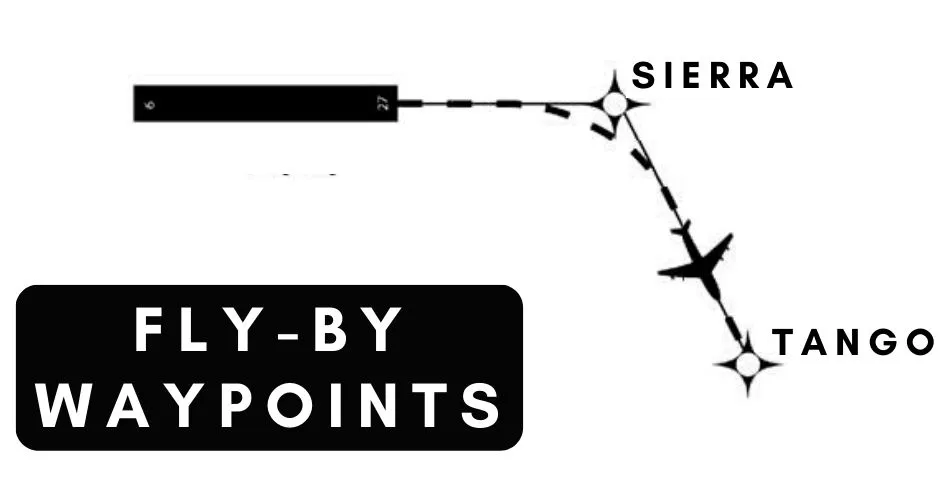
When an aircraft is initiating a turn to the next course prior to reaching the waypoint, the Fly-by waypoints are used. The waypoint will be separating two route segments as shown in the figure above.
On the other hand, Fly-over Waypoints are used when the pilots require their aircraft to fly over the point before initiating a turn (illustrated in the figure below.)
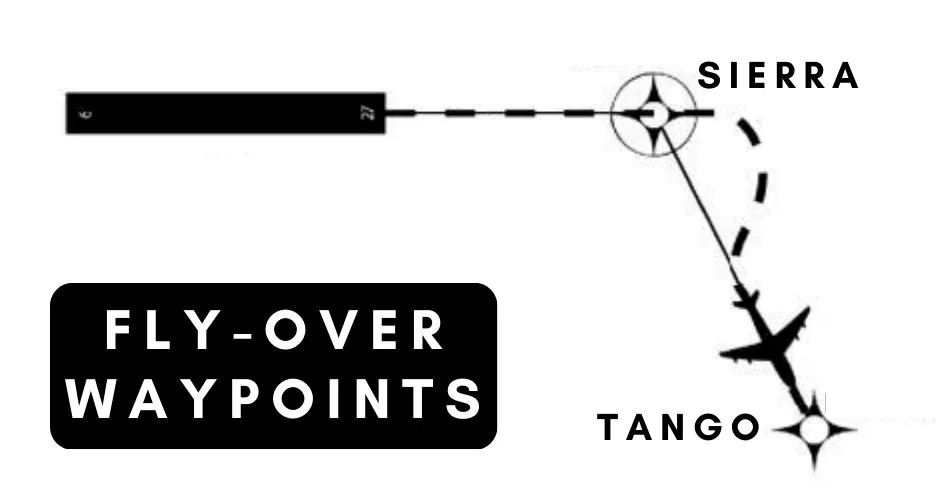
Like Waypoints, there are five types of Legs used by the RNAV approach. Track to Fix, Direct to Fix, Course to Fix, Radius to Fix, and Heading are the five leg types that determine the path, and the termination point for the RNAV Approach procedure.
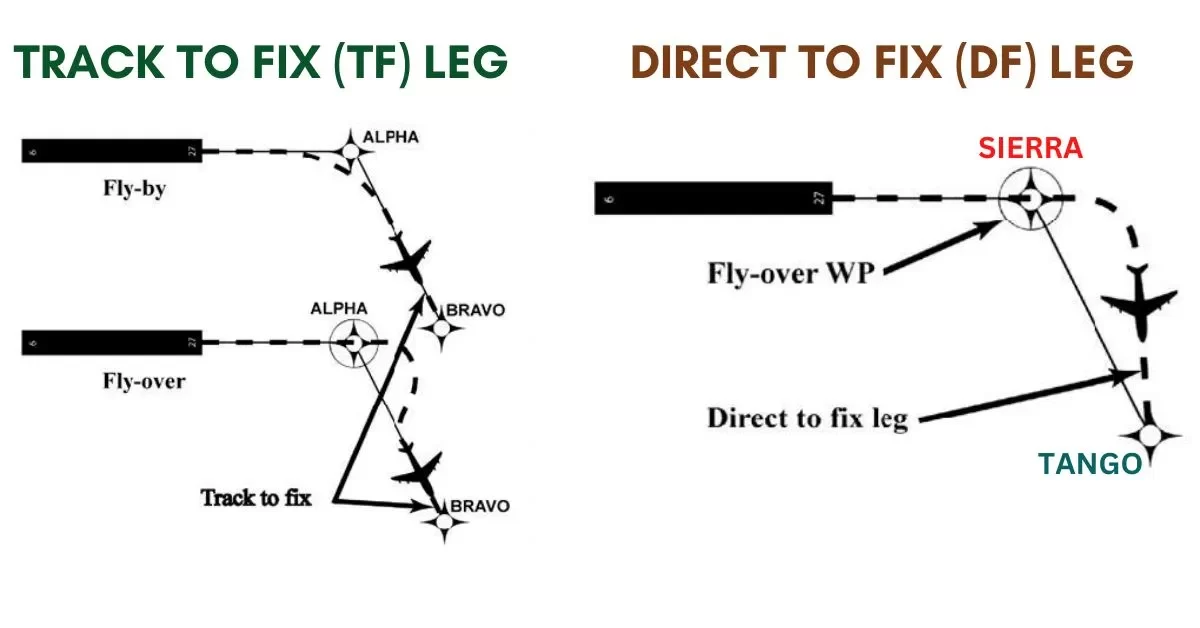
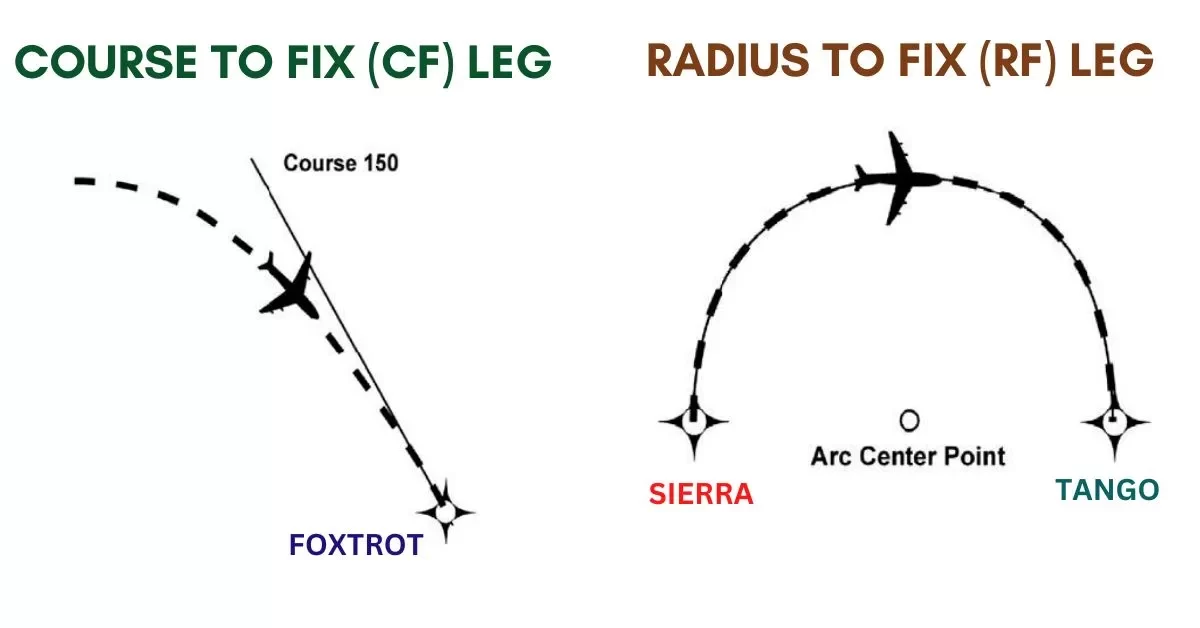
Track to Fix (TF) legs are sometimes called point-to-point legs as they are intercepted as the flight track to the upcoming waypoint.
Direct to Fix (DF) leg represents an aircraft’s track from an initial area direct to the following waypoint.
Course to Fix (CF) leg’s path terminates at a fix with a specified course at that fix.
The Radius to Fix (RF) leg is a constant circular path around a defined turn center that terminates at a fix.
A Heading Leg features Heading to DME Range (VD), Heading to Manual Terminal (VM), and Heading to Altitude (VA).
All these technical settings are managed in the aircraft’s Flight Management System (FMS) which is equipped with sensors, receivers, and computers. The navigation database stored in this system provides guidance for RNAV Approach procedures.
For instance, RNAV uses GPS technology to acquire RNAV Approach inputs, and then the inputs are transferred to displays and automatic flight control systems.
Once the waypoints, legs, and other important assistance are activated, the flight crew can safely navigate their aircraft from the final approach fix down to the minimum descent altitude within a normal position to land before reaching the missed approach point. The FMS uses GPS and/or DME technology for live aircraft position updates.
What are the types of RNAV approaches?
RNAV Approach is a type of Non-Precision Approach (NPA) that may not include vertical guidance to assist precise landing. However, there are some types of RNAV approaches featuring vertical guidance which we will discuss below.
Types of RVAN Approaches
NPA (Non-Precision Approach)
In this approach, RNAV doesn’t offer vertical guidance which means only lateral guidance will be provided. It is flown to the LNAV (Lateral Navigation), or the LP MDA/H.
APV Baro (Approach with Vertical Guidance)
RNAV Approach with APV Baro is carried out with barometric vertical guidance. This vertically guided RNAV approach can be flown by modern aircraft equipped with VNAV (Vertical Navigation) functionality that uses barometric inputs.
The majority of Boeing and Airbus are installed with VNAV functionality meaning pilots can execute the APV Baro RNAV Approach with a majority of the modern fleet.
APV SBAS (Satellite-Based Augmentation Systems)
APV SBAS is an advanced system that can be used for the RNAV approach to fly the aircraft from the Approach fix to the LP (Localizer Performance) Minima. LNAV, LP, LNAV/VNAV, and LPV (Localizer Performance with Vertical Guidance) are the 4 most common minima types.
APV SBAS is assisted by Satellite Based Augmentation Systems such as WAAS (USA–Wide Area Augmentation System), and EGNOS (Europe–European Geostationary Navigation Overlay Service).
When pilots are conducting an RNAV approach with APV SBAS, they are provided with both lateral, and vertical guidance. The lateral guidance is equivalent to an ILS localizer whereas vertical guidance is provided against a geometrical path in space rather than a barometric altitude.
Types of RNAV Navigation Specifications (Nav Specs)
There are certain sets of aircraft and flight crew requirements that need to be followed for RNAV approaches. Such requirements are represented with the numerical designation.
As defined by the FAA, the numerical designation refers to the lateral navigation accuracy in nautical miles which is expected to be achieved at least 95 percent of the flight time by the population of aircraft operating within the airspace, route, or procedure.
What is a Lateral Accuracy Value? It is a value represented as a distance in nautical miles from the intended centerline of a procedure, route, or path. This value is applicable to selected airspace, route, or procedure.
RNAV 1, RNAV 2, and RNAV 10 are three types of RNAV Specs used for various flight applications shown in the table below.
| RNAV Nav Specs | DESIGNATION |
| RNAV 1 | Used for Departures (DPs), and Standard Arrivals (STARs) |
| RNAV 2 | Used for En-route operations |
| RNAV 10 | Used in Oceanic Operations |
Is autopilot required for RNAV?
RNAV Approach must be conducted with Autopilot (AP), and Flight Director (FD). There are two autopilot systems in today’s modern aircraft, and RNAV requires only one.
Sometimes, a manual FD RNAV Approach is allowed when both autopilot systems have malfunctioned, or failed.
How to fly RNAV Approach?
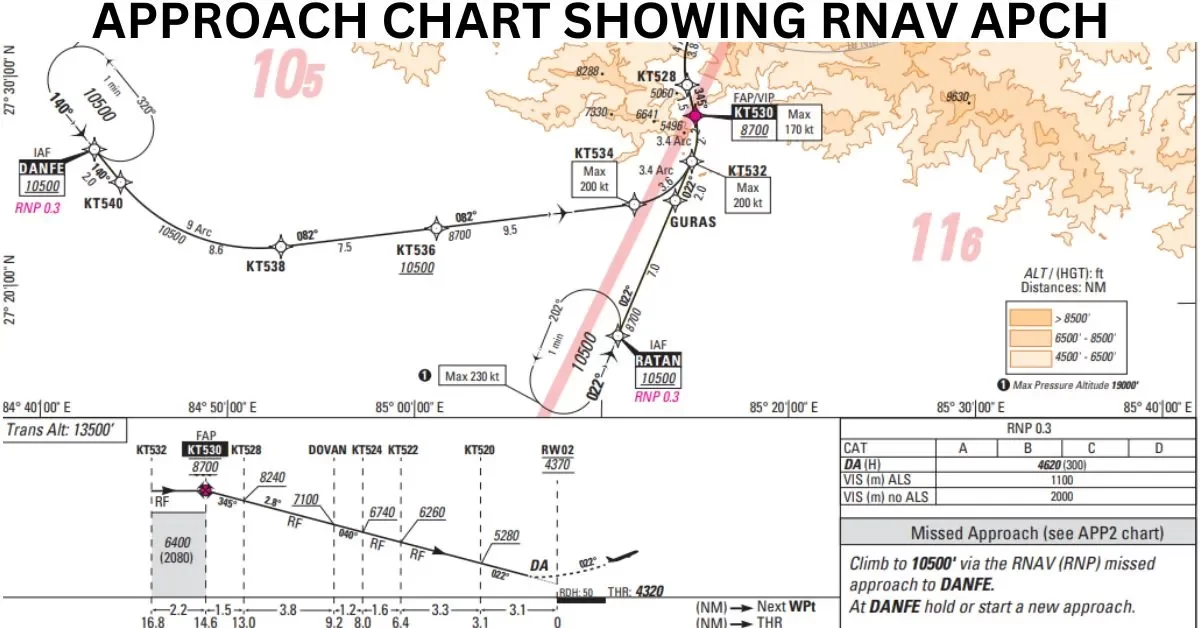
Before flying RNAV Approach, you as a pilot must be aware of various terms we discussed above such as waypoints, legs, types of RNAV approaches, aircraft compatibility, and so on.
To fly RNAV Approach, you will use GPS Waypoints, and Legs calculated by the Flight Management System (FMS). The navigational database stored in the FMS will guide you throughout your journey from the Approach Fix to the minimum descent altitude.
The key steps for the RNAV approach are listed below.
- Step 1: Use onboard computers to get ready (Activate, and Confirm) for the RNAV Approach as it will calculate the GPS Waypoints.
- Step 2: Follow the Waypoints, and pass the Initial Approach Fix.
- Step 3: Once you are near the Final Approach Fix, you need to press the Approach button represented by ‘APPR’. The Primary Flight Display (PFD) will display the vertical, and lateral guidance for the final approach depending on the type of RNAV Approach.
- Step 4: After you reach the decision altitude, you need to turn off the autopilot, and the flight director to manually land the aircraft as the landing runway will be visible.
You can watch the following simulator video created with Microsoft Flight Simulator to get basic idea of flying RNAV Approach.
What are the advantages of the RNAV Approach?
The major advantages of the RNAV Approach include:
- Generation of more direct, efficient, and flexible routes.
- Doesn’t require pilots to rely on ground-based navigation aids.
- RNAV Approach is cost-effective as it allows aircraft to arrive faster at the destination.
- Can reduce required ATC radio transmissions with efficient use of airspace.
What are the limitations of the RNAV Approach?
With advantages, there are some limitations of the RNAV approach which are listed below.
- Aircraft must be equipped with VNAV/LNAV functionality, and a modern Flight Management System to use RNAV Approach for obtaining minima.
- The basic RNAV Approach is a non-precision approach meaning pilots must be active, and alert while navigating, approaching, and landing.
- Errors might occur as it occurs in VOR, DME, and VORTAC Systems.
- The pre-stored navigational database may cause unexpected interaction due to the limitation of data the FMC Software can handle.
Is RNAV more accurate than ILS?
RNAV is a type of Non-Precision Approach (NPA) whereas ILS (Instrument Landing System) is a Precision Approach (PA).
ILS uses localizer, and glideslope which are ground-based navigational aids that provide lateral, and vertical guidance on a stabilized continuous descent path. An autoland can be executed with ILS.
On the other hand, RNAV uses satellite-based technology to bring the aircraft where the runway is in view, and a visual landing can be executed. RNAV Approach conducted with APV SBAS can bring the aircraft to 4 minima levels including VNAV/LNAV, LPV, LP, and LNAV.
Talking about accuracy, ILS is more accurate than RNAV because it is certified as the Precision Approach system by ICAO.
Conclusion on ‘What is RNAV Approach?’
If you have gone through all topics above, you must be clear about the RNAV Approach.
To end it meaningfully, let’s recap the significance of the RNAV Approach in the following points.
- RNAV is known as Area Navigation, and RNAV Approach is a Non-Precision Approach (NPA) that doesn’t rely on ground-based navigational aids.
- RNAV Approach allows aircraft to navigate from the approach fix down to the minimum descent altitude. RNAV with vertical guidance can offer an almost precise landing option.
- RNAV Approach combined with LPV, APV Baro, and APV SBAS can provide more accurate guidance. These approach types offer both vertical, and lateral guidance but for that, the aircraft must feature LNAV/VNAV functionality.


